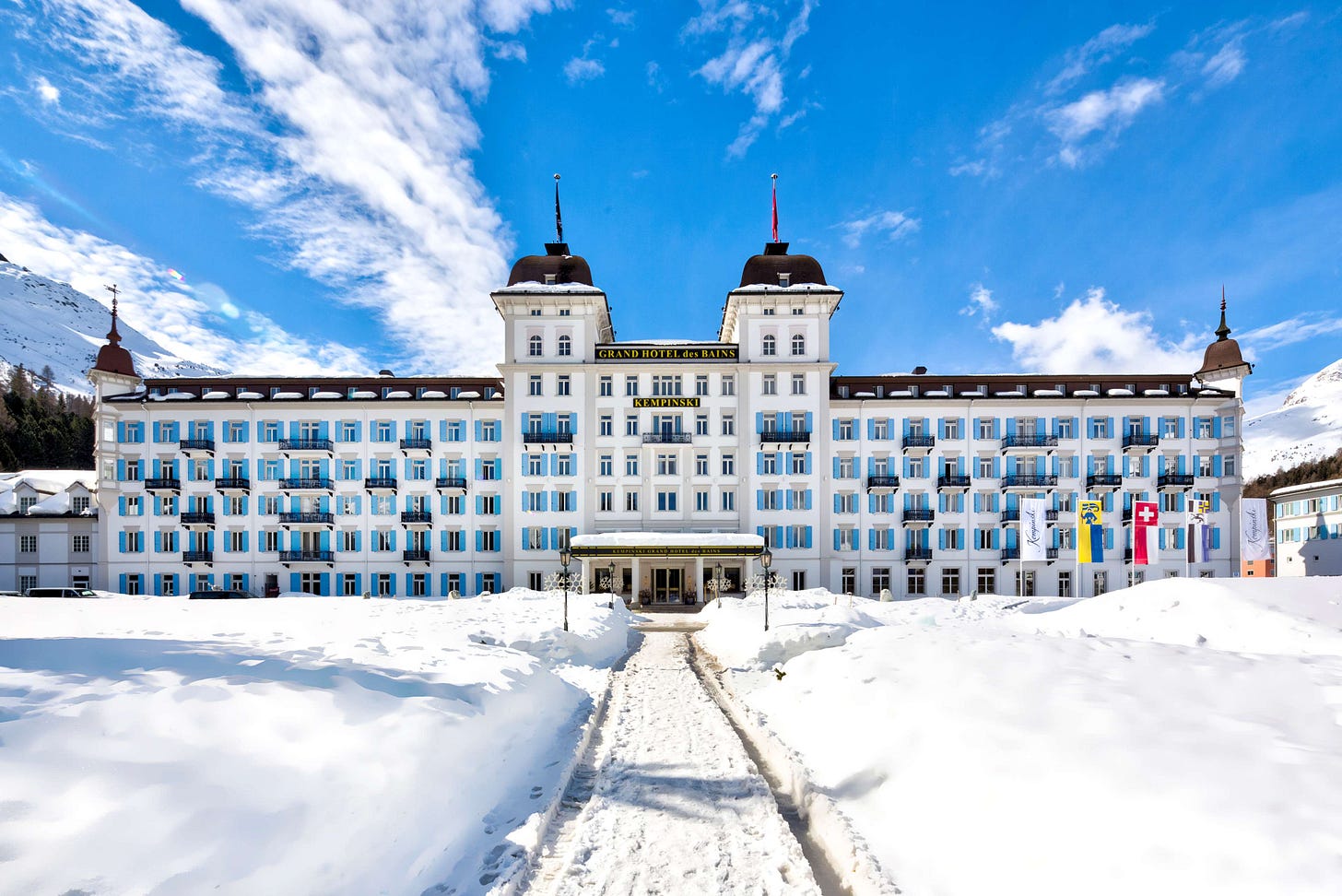Dear Insider,
Big events deserve extra attention. With this special edition of The Swiss Insider, we take a closer look at the tie-up between UBS and Credit Suisse.
No story has more dominated the conversation in recent days - and while it is far from over, some details are worth considering…
In this edition, you will find:
The backstory - where it all started
The people - who are (still) involved
Two special places - locations that played a role
The numbers - as awful as they are
Feel free to leave your comments - or share this edition with your network!
🔍The backstory
Credit Suisse’s demise and subsequent takeover by UBS is a story of power and money and stupidity on many levels. It is also the story of pure economics and hard-nosed business. While Swiss media reported as early as 2020 that former UBS Chairman Axel Weber had been laying the groundwork to vault his firm into the big leagues of European and North American banks with a takeover. In fact, the planning had already begun four years earlier - according to BILANZ Magazine - when UBS executives gathered in St. Moritz to discuss strategy. The move was codenamed “Operation Signal” - a reference to the “Signalbahn” train line with its stop right outside the bar of luxury hotel Kempinski.
The irony? At that time, Axel Lehmann was in charge of the Corporate Center at UBS and his colleague Ulrich Körner was leading the bank’s asset management division.
They were both later to play a tragic role in the final endgame…
👨The people (still) in the room
The cast of characters involved in the UBS-Credit Suisse match is long. This is not an exhaustive list. Some names have been in the bright glare of the media for weeks now. Others are just coming to light…
Colm Kelleher
The almighty Irishman is clearly the most powerful banker in Switzerland at the moment. His efforts to push the UBS share price up with personal visits to investors in the US, his deft comments about China and most of all, his power politics in pulling off the merger and subsequent recall of Ermotti make him an intriguing figure for years to come. Whether he lives to regret his accension to the Swiss banking throne remains to be seen…
Axel Lehmann
At the all-important press conference Lehmann cut a sad figure. Media reports of his desperate intervention with regulators during negotiations made him look even weaker. But his sincere apology and “from-the-heart” performance at the Credit Suisse shareholder meeting (see below) redeemed him…somewhat. His experience at UBS will leave questions hanging about his true loyalties in the entire situation…
Ralph Hamers
Perhaps the luckiest man in the entire saga, (now) former UBS CEO Hamers is on his way out. He graciously accepted his role, and graciously thanked shareholders and colleagues at the annual meeting (see below) for “listening once again to his German”. Hamers leaves UBS in good shape - but with many cultural questions still to be resolved. His “agile” methodology may get scrapped now that old-time banking is back in style with Ermotti. On the other hand, the merger may prove the value of the Dutchman’s way of operating. Mashing up two stiff, inflexible organizations, after all, might just be a recipe for disaster…
Sabine Keller-Busse
The UBS chief in Switzerland was a rising star under Ermotti before. Now her position becomes even more important as the main player in one of the most hotly contested aspects of the merger. Voters and many politicians want the Swiss business of UBS and Credit Suisse to stay separate. Keller-Busse may yearn for greater power and market share - but the cards (and her CS counterpart, André Helfenstein) are likely stacked against her.
André Helfenstein
Of all Credit Suisse executives, Helfenstein had perhaps the easiest job of all. The Swiss business of the big bank was highly profitable and reasonably well-managed. It fell to Helfenstein to try and stem the tide of client outflows when things got desparate on 15 March. His interview on Blick, however, came too late. Now he goes up against Keller-Busse in an effort to either consumate the forced integration - or hold onto power…for now.
Ulrich Körner
The last CEO of an independent Credit Suisse enjoyed strong support from his chairman - but clearly he was not up to the job. His final remarks at the shareholder meeting (see below) reflected the appropriate regret - but not the necessary self-reflection. In the end, many experts agree that his restructuring plan may well have worked, but time was not on his side. Nor was his character and previous ties to UBS…
Sergio Ermotti
The return of the king to Paradeplatz came as a surprise - and some fanfare. Now the hard part begins. One of Ermotti’s first acts as CEO of the soon-to-be combined bank was to write a letter to Credit Suisse employees. It urged them to focus on clients and keep the business running. His job is made harder by reports that many of the CS top-team, angered by losing their bonuses, have all but given up… Many of its investment bankers have already moved on
Josef Ackermann & Oswald Grübel
Two former titans of the Swiss banking scene have not disappeared altogether. According to media reports, Grübel, former CEO of both UBS and Credit Suisse, along with former Deutsche Bank boss Josef Ackermann worked behind the scenes to assemble enough capital to help save Credit Suisse. Their group apparently included former Barcklay’s CEO Bob Diamond and billionaire Hansjörg Wyss. In the end, they were unsuccessful…
Mike Dargan
The smiling man in the shadows, Dargan has been Chief Digital and Information Officer at UBS for the past two years. Now he is tasked with overseeing the integration of UBS and Credit Suisse - especially on a technical level. With vastly different systems and thousands of soon-to-be-redundant employees, Dargan has perhaps the biggest job of all.
🔥The meetings
This week both UBS and Credit Suisse held their Annual Shareholder Meetings. In the case of Credit Suisse - for the very last time. It was hot…and heavy…
“Truly sorry…”
Credit Suisse Chairman Axel Lehmann expressed deep regret at the dramatic turn of events. He cut a tragic figure - along with CEO Ulrich Körner - in front of a huge crowd at Zürich’s Halinstadion.
Security on-site was decidely higher than usual. The first shareholder to speak referenced the fact when he declared: “I didn’t bring a pistol today….”
Another of his frustrated friends was even more dramatic - he offered the CS Board of Directors empty walnut shells as a sign of how much he thought the bank’s shares were worth. A third suggested that interns could have done a better job.
In the end, most motions before the shareholders were passed, with the exception of the compensation package for executives - a sum north of $30 million in total.
Now it remains to be seen if the bank’s top leaders have to work for free….
A difficult stretch of road…
UBS shareholders, meeting one day after the Credit Suisse meeting, were less volatile, but still skeptical.
Some urged UBS to sue The Financial Times for writing too much about the takeover deal while it was ongoing. Others railed against the greed of capitalism (with a specially written song). In the end, the majority approved all agenda items and the winner was happy.
It remains to be seen whether new CEO Ermotti will be as happy in 2 years…
🏦The spot(s)
The so-called Operation Signal, reported on this week in BILANZ Magazine is said have been first discussed in the 5-star luxury Hotel Kempinski in St. Mortiz. Here UBS top managers laid the groundwork for what was later to come…
UBS Chairman Colm Kelleher is a patriotic Irishman. Rumor has it that on the eve of the UBS-Credit Suisse merger he was anxious to sit down to a pint of Guiness at his favorite Irish pub - James Joyce - in the center of Zürich to watch Ireland compete in the Rugby World Cup.
Other events prevented that pleasure….
‼ The nasty numbers
While the purchase price (just over CHF 3 billion) that UBS has agreed to pay for Credit Suisse, is the most widely discussed number of the entire story - a whole array of other numbers stand out…
CHF 0.76
It was (or is) the deal of the century. UBS agreed to pay a mere 0.76 per Credit Suisse share. Most people agree - it was a steal. The big question remained whether shares of the stricken bank would continue to trade - and they do. At the time of writing, the stock has been trading north of CHF 0.80.
Up to 35’000
The biggest risk - and the one giving Swiss politicians sleepless nights - is the number of potential redundant jobs as a result of the merger - up to 35 000. Ongoing discussions about whether to merge or separate the two banks’ Swiss units may play a significant role in the number of layoffs. A combined domestic bank would involve major cuts - something that is already expected in the investment banking unit, where UBS sees little value in retaining all but the most highly-skilled (and culturally acceptable) rain-makers.
CHF 50 billion
Rumors and innuendo have played a major role in the demise of Credit Suisse. Shortly after the deal was announced, CH Media Group raised the alarm that the state-backed rescue package (with guarantees for UBS) would actually cost CHF 50 billion more than widely reported. The information was later denied - since that sum was only counted as “additional liquidity” - not a guarantee.
CHF 60 billion
Bankers live for their bonuses. Now the Swiss government has stepped in - again, to quell political pressure - and put the kabosh on extra payouts for top Credit Suisse execs. Members of the executive management will get nothing. Those below them will have their payday halved or reduced by a quarter.
CHF 2.5 million
Sergio Ermotti returns as the savior of the UBS-Credit Suisse marriage. He will have a big job to do - and not such a big salary, at least in fixed compensation. His package will include a CHF 2.5 million payout per year. If he does his job well, he may just get more…





